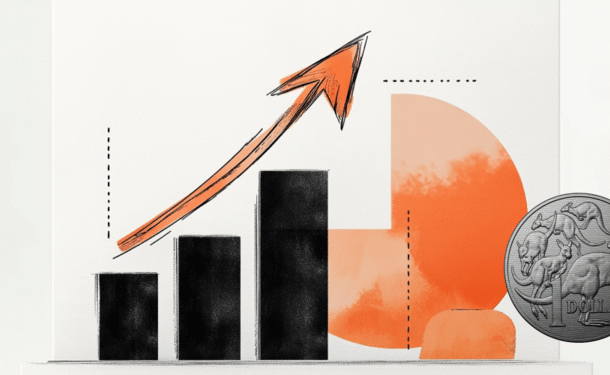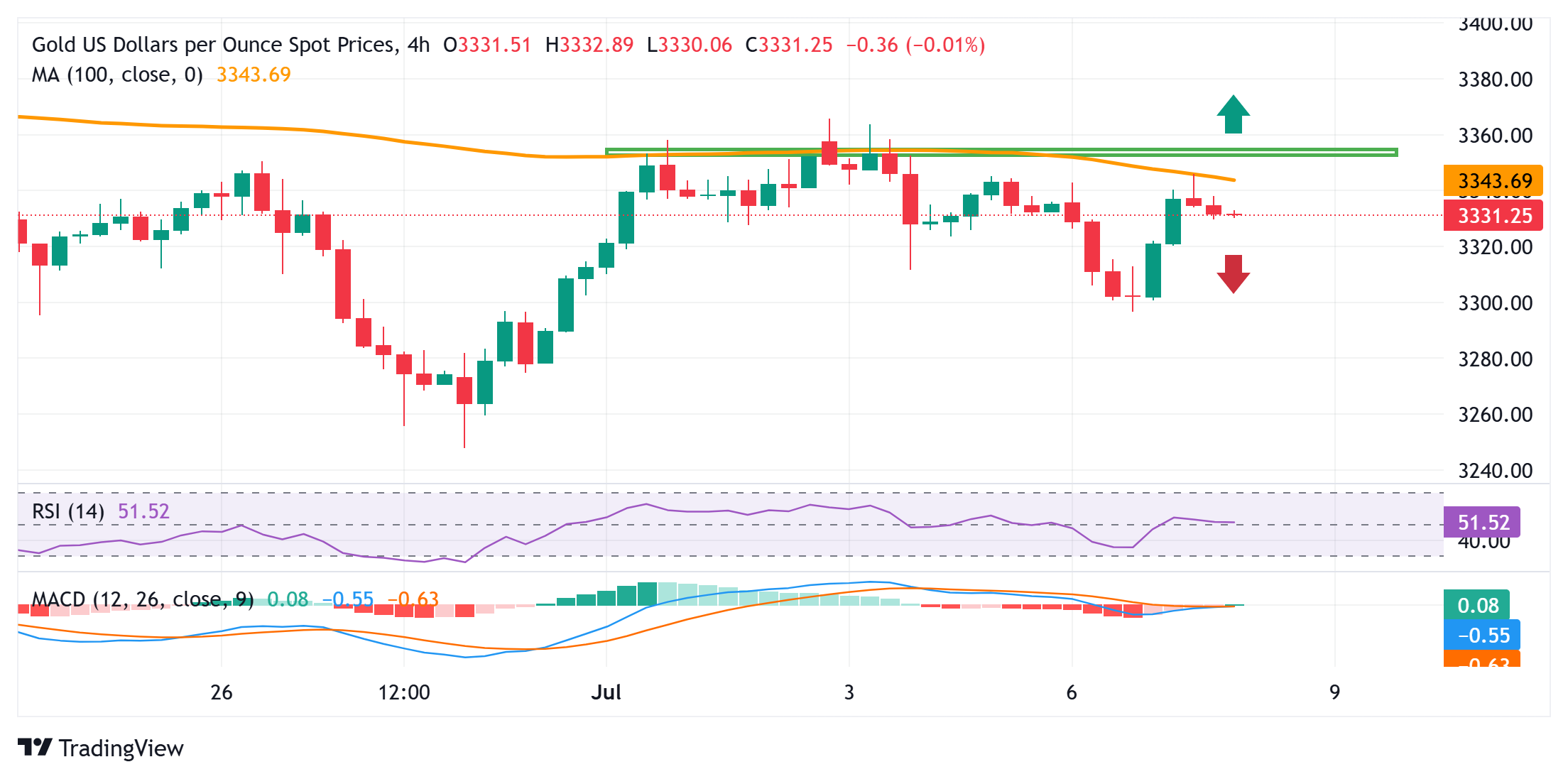
- Gold price edges lower on Tuesday amid diminishing odds for a rate cut by the Fed in July.
- Concerns about the economic fallout from Trump’s tariffs weigh on investors’ sentiment.
- The emergence of some USD weakness contributes to limiting losses for the XAU/USD pair.
Gold price (XAU/USD) remains depressed heading into the European session on Tuesday, though it lacks bearish conviction and holds comfortably above a one-week low touched the previous day. Expectations that US President Donald Trump’s tariffs would underpin US inflation in the coming months and force the Federal Reserve (Fed) to keep interest rates steady turned out to be a key factor undermining the non-yielding yellow metal.
The US Dollar (USD), however, struggles to lure buyers amid worries about the potential economic fallout from Trump’s trade tariffs and US fiscal concerns. Apart from this, persistent geopolitical risks act as a tailwind for the safe-haven Gold price. Traders also seem reluctant and opt to wait for more cues about the Fed’s rate-cut path before placing fresh directional bets. Hence, the focus remains glued to FOMC minutes on Wednesday.
Daily Digest Market Movers: Gold price bulls remain on the sidelines amid reduced Fed rate cut bets
- US President Donald Trump extended the deadline for the imposition of reciprocal tariffs to August 1 and also released letters outlining higher trade tariffs against a slew of Asian and African countries. Trump also threatened that any Country aligning with the anti-American policies of BRICS will be charged an additional 10% tariff and there will be no exceptions to this policy.
- The Federal Reserve is now expected to keep interest rates elevated in anticipation of worsening inflation as a result of higher import taxes and a still resilient US labor market. This, in turn, lifted the US Dollar to a nearly two-week high on Monday and turned out to be a key factor that undermines demand for the non-yielding Gold price during the Asian session on Tuesday.
- The USD bulls, however, seem reluctant amid the uncertainty over the potential economic impact of Trump’s tariffs and US fiscal concerns. Adding to this, a fresh wave of the global risk-aversion trade – as depicted by a sea of red across the global equity markets – could lend support to the safe-haven precious metal and warrants caution for aggressive bearish traders.
- In the absence of any relevant market-moving economic data from the US on Tuesday, the market focus will remain glued to the release of FOMC meeting minutes on Wednesday. Investors will look for more cues about the Fed’s rate-cut path, which, in turn, will drive the USD demand in the near term and provide a fresh directional impetus to the non-yielding yellow metal.
Gold price bears have the upper hand while below the 100-SMA on H4; $3,300 mark holds the key

The overnight goodish rebound faced rejection near the 100-period Simple Moving Average (SMA) on the 4-hour chart. The said barrier is currently pegged near the $3,347-3,348 region and is followed by $3,358-3,360 supply zone. A sustained strength beyond the latter could trigger a short-covering move and allow the Gold price to reclaim the $3,400 round figure.
On the flip side, the $3,300-3,295 area might continue to protect the immediate downside, below which the XAU/USD pair could accelerate the fall towards the next relevant support near the $3,270 horizontal zone. The downward trajectory could get extended and eventually drag the Gold price to the $3,248-3,247 region, or the June monthly swing low.
Gold FAQs
Gold has played a key role in human’s history as it has been widely used as a store of value and medium of exchange. Currently, apart from its shine and usage for jewelry, the precious metal is widely seen as a safe-haven asset, meaning that it is considered a good investment during turbulent times. Gold is also widely seen as a hedge against inflation and against depreciating currencies as it doesn’t rely on any specific issuer or government.
Central banks are the biggest Gold holders. In their aim to support their currencies in turbulent times, central banks tend to diversify their reserves and buy Gold to improve the perceived strength of the economy and the currency. High Gold reserves can be a source of trust for a country’s solvency. Central banks added 1,136 tonnes of Gold worth around $70 billion to their reserves in 2022, according to data from the World Gold Council. This is the highest yearly purchase since records began. Central banks from emerging economies such as China, India and Turkey are quickly increasing their Gold reserves.
Gold has an inverse correlation with the US Dollar and US Treasuries, which are both major reserve and safe-haven assets. When the Dollar depreciates, Gold tends to rise, enabling investors and central banks to diversify their assets in turbulent times. Gold is also inversely correlated with risk assets. A rally in the stock market tends to weaken Gold price, while sell-offs in riskier markets tend to favor the precious metal.
The price can move due to a wide range of factors. Geopolitical instability or fears of a deep recession can quickly make Gold price escalate due to its safe-haven status. As a yield-less asset, Gold tends to rise with lower interest rates, while higher cost of money usually weighs down on the yellow metal. Still, most moves depend on how the US Dollar (USD) behaves as the asset is priced in dollars (XAU/USD). A strong Dollar tends to keep the price of Gold controlled, whereas a weaker Dollar is likely to push Gold prices up.
Information on these pages contains forward-looking statements that involve risks and uncertainties. Markets and instruments profiled on this page are for informational purposes only and should not in any way come across as a recommendation to buy or sell in these assets. You should do your own thorough research before making any investment decisions. FXStreet does not in any way guarantee that this information is free from mistakes, errors, or material misstatements. It also does not guarantee that this information is of a timely nature. Investing in Open Markets involves a great deal of risk, including the loss of all or a portion of your investment, as well as emotional distress. All risks, losses and costs associated with investing, including total loss of principal, are your responsibility. The views and opinions expressed in this article are those of the authors and do not necessarily reflect the official policy or position of FXStreet nor its advertisers. The author will not be held responsible for information that is found at the end of links posted on this page.
If not otherwise explicitly mentioned in the body of the article, at the time of writing, the author has no position in any stock mentioned in this article and no business relationship with any company mentioned. The author has not received compensation for writing this article, other than from FXStreet.
FXStreet and the author do not provide personalized recommendations. The author makes no representations as to the accuracy, completeness, or suitability of this information. FXStreet and the author will not be liable for any errors, omissions or any losses, injuries or damages arising from this information and its display or use. Errors and omissions excepted.
The author and FXStreet are not registered investment advisors and nothing in this article is intended to be investment advice.







